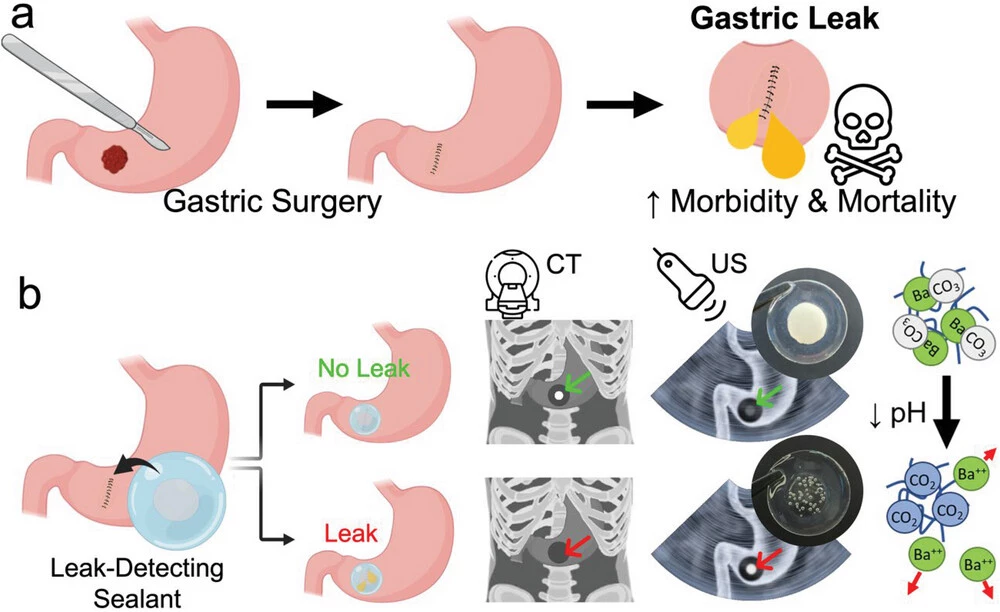Leaking sutures following abdominal surgery presents a potentially life-threatening complication that surgeons might not pick up immediately. Researchers have now developed a hydrogel patch that not only assists with wound closure but rapidly detects leaks at suture sites inside the abdomen.
When a surgeon removes a section of the intestine, say, and sutures the ends together in what’s called anastomosis, there’s a chance that it can leak. The problem is that once the skin is closed, a surgeon may be blind to whether or not a leak is occurring inside the abdominal cavity.
Anastomotic leaks cause highly acidic gastric fluids to spill into the abdominal cavity and can lead to severe complications such as inflammation and infection of the tissues that line the cavity (peritonitis) as well as life-threatening blood infection (sepsis). A leak is often only discovered once a patient has developed symptoms such as pain and fever and their overall health has deteriorated.
The problem with developing a device that either aids anastomotic closure or monitors it for leakage is that it must withstand the high acidity of gastrointestinal fluids without breaking down. Now, researchers from the Swiss Federal Laboratories for Materials Science and Technology (Empa) and ETH Zurich have developed a leak-detecting patch that can withstand the acidic environment of the gut and may also help with wound closure.
“Surgeons have told us that they keep a close eye on the surgical field during even the most complicated procedures – but as soon as the abdominal cavity is closed, they are ‘blind’ and may not notice leaks until it is too late,” said Alexandre Anthis, one of the study’s corresponding authors.
The patch comprises a layered hydrogel matrix embedded with carbonate salts, either barium or lanthanum, which act as non-electronic sensors. Barium carbonate is already commonly used as an X-ray contrast agent, while lanthanum carbonate is used to decrease high blood phosphate levels caused by kidney disease.
When the carbonate comes into contact with acidic digestive fluids, it decomposes, producing bubbles of carbon dioxide which remain trapped in the hydrogel matrix. The bubbles can be seen using ultrasound because they stand out from the surrounding tissue due to their high contrast.
As a kind of ‘backup’ leak detection mechanism, the patch also changes shape in the presence of digestive fluids – into a ring or line – making it easy to pick up with a computed tomography (CT) scan. This means the patch offers ‘dual modality’ sensing, with leaks visible on both ultrasound and CT, including ultralow radiation dose CT.

“In future, a sensor whose shape clearly stands out from anatomical structures in CT and ultrasound images could reduce ambiguity of impending leak diagnostics,” said Inge Herrmann, a co-corresponding author of the study.
Testing their patch in piglet models, the researchers found that both carbonates reacted solely to acid conditions related to contact with gastric fluids and were, therefore, less likely to produce false positives. Depending on the area of the leak, the reaction produced by contact with gastric acid occurred within minutes or a few hours. Ordinarily, healthcare professionals would have to rely on clinical signs of a leak which can take time to materialize.
What’s more, the carbonate sensors are encapsulated in polyacrylamide, a water-absorbant polymer that allows the patch to adhere firmly to the wound site, sealing it while simultaneously stopping it from moving. This, say the researchers, could reduce the risk of complications post-abdominal surgery and shorten hospital stays.
While further studies are needed to determine the long-term fate of their wound-supporting sensor patch, the researchers say their device offers a cost-effective way of rapidly detecting leaks, enabling timely treatment.
“The intestinal patch project is already attracting a great deal of interest from the medical profession,” said Herrmann.
The study was published in the journal Advanced Science and the below video, produced by Empa, outlines the benefits of the leak-detecting patch.
Source: Empa







